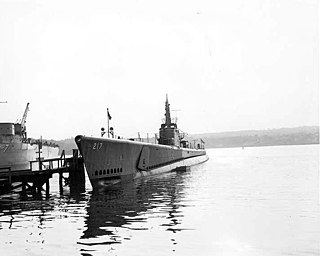
USS Guardfish (SS-217), a Gato-class submarine, was the first ship of the United States Navy to be named for the guardfish.
The Wigham Richardson shipbuilding company was named after its founder, John Wigham Richardson (1837-1908), the son of Edward Richardson, a tanner from Newcastle upon Tyne, and Jane Wigham from Edinburgh.
SS Santhia was a 5,544 GRT steam cargo liner built for the British-India Steam Navigation Company in 1901 by William Denny & Brothers, Dumbarton. She was sold to Japan in 1923 and was in service until 1935, when she was scrapped.
SS Tregenna was a cargo steamship that was launched in England in 1919 and sunk by a U-boat in the Battle of the Atlantic in 1940 with the loss of 33 of her 37 crew. She was laid down as War Bulldog, but the Hain Steam Ship Co bought her before she was completed and renamed her Tregenna.

HMS Baralong was a cargo steamship that was built in England in 1901, served in the Royal Navy as a Q-ship in the First World War, was sold into Japanese civilian service in 1922 and scrapped in 1933. She was renamed HMS Wyandra in 1915, Manica in 1916, Kyokuto Maru in 1922 and Shinsei Maru No. 1 in 1925.

SS Monte Nevoso was a cargo steamship that was launched in 1920 in England, owned in Italy, and wrecked in 1932 in the North Sea off the coast of Norfolk.
Stettin was a 2,646 GRT cargo ship which was built in 1923 for the Stettiner Dampfer Compagnie. In 1930 she was sold to Norddeutscher Lloyd and renamed Akka. She was requisitioned by the Kriegsmarine in 1940. Akka was seized as a war prize in 1945, passing to the Ministry of War Transport (MoWT) and being renamed Empire Calder.
SS Empire Cobbett was a 9,811 GRT tanker which was built in 1942 by Furness Shipbuilding Co Ltd, Haverton Hill-on-Tees for the Ministry of War Transport (MoWT). In 1946 she was sold into merchant service and renamed San Wilfrido. She was scrapped in 1959.
SS Canonesa was a refrigerated cargo steamship that was built in Ireland in 1920 and sunk by a u-boat in the Atlantic Ocean in 1940.
Sand Star was a 489 GRT dredger that was built in 1943 as the coaster Empire Dyke Clelands (Successors) Ltd, Wallsend, Northumberland, United Kingdom for the Ministry of War Transport (MoWT). She was transferred to the Netherlands in 1943 and renamed Prinses Margriet. In 1954, she was sold to the United Kingdom and renamed Sand Star. She served until 1966 when she sank following a collision.
SS Calabria was a passenger and cargo steamship. AG Weser built her for Norddeutscher Lloyd. She was launched as D/S Werra and completed in 1922.
SS Hertford was a refrigerated cargo steamship that was launched in Germany in 1917, seized by the United Kingdom in 1920 as World War I reparations, and sunk by a U-boat in 1942 with the loss of four members of her crew.
SS British Transport was a general cargo steamship that was built in England in 1910 and scrapped in Italy in 1933. In 1917 she became the first merchant ship to succeed in sinking a u-boat.

SS Westernland was a transatlantic ocean liner that was launched as Regina in Scotland in 1917, renamed Westernland in 1929 and was scrapped in 1947. She began her career as a troop ship repatriating US troops after the Armistice of 11 November 1918. In the Second World War, Westernland served as a troop ship, repair ship and destroyer depot ship.

Empire Fowey was a 19,121 GRT ocean liner that was built in 1935 as Potsdam by Blohm & Voss, Hamburg for the Hamburg America Line. She was sold before completion to Norddeutscher Lloyd. While owned by Norddeutscher Lloyd she was one of three sister ships operating the service between Bremen and the Far East. Her sister ships were SS Scharnhorst and SS Gneisenau.

Furness Bermuda Line was a UK shipping line that operated in the 20th century. It was part of Furness, Withy and ran passenger liners between New York and the British Overseas Territory of Bermuda from 1919 to 1966.

MV Bermuda was a 19,086 GRT passenger ship that Furness, Withy's Furness Bermuda Line operated between New York and Bermuda from 1928 until 1931.
SS Benlomond was a British merchant ship torpedoed in the South Atlantic by a German U-boat in 1942. Built in 1922 as Cynthiana, over the next two decades she passed through a number of owners and had several different names; Hoosac (1922), London Corporation (1922-1937), Marionga J. Goulandris (1937-1938) and finally Benlomond from 1938 to 1942.
SS Verdala was a cargo and passenger steamship that was built in Scotland in 1913. Several times she changed owners and was renamed: as Mongolian Prince in 1917, Istok in 1928 and finally Maycrest in 1940.








